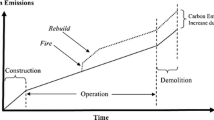Abstract
Building’s fire prevention strategy tailored with the creation of urban buildings design has developed rapidly while promoting the more advanced modern cities. After nearly a hundred years of experiences in fire protection, the concept of building’s fire protection of the so-called active fire protection design and passive fire protection design has gradually been reformed. With the development of high-speed computer technology and the improvement of modern science and technology, a new concept of the so-called performance-based fire protection design could be first traced down as early as 1970s when the goal-oriented approach to building fire safety was developed by the U.S. General Services Administration. The design concept uses the computational fluid dynamic (CFD) software to obtain the movement data and the trace of fire and smoke, temperature distribution, gas concentration’s distribution cloud map, and other parameters. The emergence of this new technology enlarged the traditional prescriptive-based fire protection design approach with the alternative design method if code complaint approach does not fit the design best. The fire protection design of complex buildings can use this technology to perform the optimized design or justification / verification analysis quantitatively and obtaining more sound results and conclusions. However, the focus is still on how to fight and control the fire while preventing the fire as the second. With the new performance based design (PBD) method, the fire risk could be mapped and quantified in order to have a better weight in analysis toward a better fire and life safety tailored design. This could be even more achieved with the new tools including the information technology, Internet of Things, cloud computing, Big Data, and artificial intelligence. The PBD approach has been used in other engineering disciplines for longer time and approved to be a scientific based sound approach, with the new empowered information cutting-edge technology captioned above, fire protection design can take the advantages without leaving behind. "Smart Building" is a new thing that is being nurtured in the current era. It is a building that provides safety, efficiency, comfort, and consumes less energy for building, people, and environment by using computer technology and Internet technology. Under the ideal condition, smart buildings are supposed to be safe and the level of fire safety can meet people's expectations based on the reliable risk management tools. The implementation includes how to recognize the building features to identify the risk levels and areas, sending signals alerting the building’s brain for further diagnosis and action. The smart building concept is getting more and more attention with penetration and coordination of various engineering disciplines. The topics we are discussing in the chapter is aimed to be a food for thoughts making a better fire protection design and ultimately a better safer world.
Access this chapter
Tax calculation will be finalised at checkout
Purchases are for personal use only
Similar content being viewed by others
References
Hurley, Morgan J., and Eric R. Rosenbaum. Performance-Based Fire Safety Design, Taylor & Francis Group, 2015. Performance based fire protection
Visual Localization system for fire brigade using BIM technology Final Report funded by the SFPE educational $ Scientific Foundation Chief Donald J Burns Memorial Research Grant, Feb 28, 2018
Cyberseurity for Fire Protection System by Lou Chavez FPE-Q42020
Author information
Authors and Affiliations
Corresponding author
Editor information
Editors and Affiliations
Rights and permissions
Copyright information
© 2022 Springer Nature Switzerland AG
About this chapter
Cite this chapter
Li, F. (2022). Intelligent Science Empowers: Building Fire Protection Technology Development. In: Naser, M., Corbett, G. (eds) Handbook of Cognitive and Autonomous Systems for Fire Resilient Infrastructures. Springer, Cham. https://doi.org/10.1007/978-3-030-98685-8_4
Download citation
DOI: https://doi.org/10.1007/978-3-030-98685-8_4
Published:
Publisher Name: Springer, Cham
Print ISBN: 978-3-030-98684-1
Online ISBN: 978-3-030-98685-8
eBook Packages: Computer ScienceComputer Science (R0)




